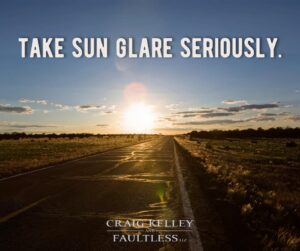
There is a cause of car and truck accidents that sometimes goes unnoticed. It affects drivers every day, in every part of the country, no matter their age or experience.
It is the glare of the sun.
Sunlight temporarily blinds us while we drive. In early morning and evening, the sun shines into drivers’ line of sight. And, though drivers cannot control the brightness of the sun, they are responsible for the accidents they cause when blinded by it. In a recent series of videos, I discussed this issue and how car and truck drivers can operate their vehicles safely.
When is sun glare the most dangerous?
Bright light always has the potential to impair drivers. However, it is at its worst around sunrise and sunset. Since the sun rises in the east and sets in the west, drivers must pay attention to the direction in which they are headed in the morning and evening.
In Indianapolis in early October, for example, the sun rises around 7:40 a.m. Folks heading eastbound during their commute to work will be driving toward the sunrise.
As we approach the winter months, it’s important to know that sun glare will worsen. In winter, the sun’s path is lower, which brings it directly into drivers’ line of sight. Additionally, snow and ice are reflective surfaces and intensify sun glare.
For most of us, facing the glare of the sun is an everyday occurrence. It can seem insignificant, but it is not.
How does sun glare affect drivers?
I recently took the deposition of a truck driver who, blinded by the sun, rear-ended our client on I-70 and nearly killed her. He said that the accident happened because he was driving west during sunset and could not see the car in front of him slowing for traffic.
This is not a valid excuse.
I have seen drivers use this excuse numerous times, but it is not valid. All drivers are required by law to operate their vehicles in a reasonably safe manner.
A vehicle driving 65 miles per hour can travel nearly 200 feet in two seconds. Mere seconds of vision loss from the sun’s glare can cause devastating wrecks.
Semi-truck drivers must avoid sun blindness.
As I mentioned above, the impact of a large truck can leave victims seriously injured or dead. Drivers of commercial motor vehicles have a duty to use extreme caution when facing sun glare. The Federal Motor Carrier Safety Administration states, “Extreme caution in the operation of a commercial motor vehicle shall be exercised when hazardous conditions, such as those caused by snow, ice, sleet, fog, mist, rain, dust, or smoke, adversely affect visibility or traction.” The regulation goes on to instruct these drivers to reduce their speed and/or stop driving until the conditions are resolved and it is safe to drive again.
So, large-truck drivers who continue to drive as normal when sun glare impairs their visibility are not exercising extreme care and are considered negligent.
There are a few precautions truck drivers can take.
1. Each driver should have multiple pairs of polarized sunglasses on their person and in their truck. These are proven to lessen — but not eliminate —the effects of sun glare.
2. Truckers can also equip their vehicles with custom-fit visors. Visors should be regularly inspected to ensure they work and fit properly.
3. Truck drivers must keep their windshields clean of dirt and grime to improve visibility. Smudges and other residue can catch the sunlight and make the glare worse.
4. The commercial motor vehicle driver can pull off the road for a short period of time until the sun sets or rises and is no longer an issue.
Parents, teach your teens to handle sun glare.
As an attorney and a parent, I have seen the failures of driver education courses. Most young drivers receive their licenses without a thorough understanding of hazards and how to handle them. This is where parents come in.
When your child has a learner’s permit, take them to practice driving during sunrise and sunset. Under your supervision, they can witness firsthand the challenges of sun glare and learn to drive safely before they are on their own.
Teach them to avoid sun glare in rural areas and in cities, where pedestrian accidents are common. Obstacles like sun glare pose a danger, not just to drivers, but to cyclists and pedestrians, as well.
Here are a few more tips for young drivers:
1. Keep your visor clear. Some drivers store papers and other belongings above their visor, which prevents them from pulling it down when they need it. It can also cause a hazard by spilling items and blocking the driver’s view.
2. If the sun is affecting your vision, slow down and maintain a greater following distance. This will give you more time to brake and react if other drivers make errors.
3. Keep polarized sunglasses in your car and wear them when it’s sunny. These are designed to filter the light that reaches your eyes and eliminate glare.
If these tips don’t help, or if you still feel uncomfortable or unsafe, look for a safe place to pull over. Within 10 or 15 minutes, the sun should shift from the horizon and out of your line of sight.
Final thoughts
Sun glare must be taken as seriously as texting while driving, drowsy driving, or driving under the influence of drugs and alcohol. According to a 2017 study, bright sunlight is a factor in one out of three daytime crashes and is “associated with a 16% increased risk of a life-threatening motor vehicle crash.”
Being prepared for glare before you even hit the road is the best way to avoid dangerous situations. Check out my recent videos about sun glare as part of the “Making Roadways Safer” series, and follow the Craig, Kelley & Faultless Facebook page to stay up-to-date with safety tips.
If you have suffered serious personal injury in a wreck caused by someone’s negligence, contact our attorneys today at (800) 746-0226 or with our online form.
David W. Craig sits on the Board of Regents of the Academy of Truck Accident Attorneys (which requires the board certification in truck accident law). He is the managing partner and one of the founding partners of Craig, Kelley & Faultless LLC. He is recognized as a Top 10 Trucking Trial Lawyer and Top 100 Trial Lawyer in Indiana by the National Trial Lawyers, as well as a Top 50 Indiana lawyer by Super Lawyers. David is the author of Semitruck Wreck, A Guide for Victims and Their Families, written to help people navigate a terrible situation by answering questions that come after a tragic wreck. He also hosts the podcast After the Crash, where you can gain valuable information about the dangers involving semis and large trucks that do not follow Indiana law safety protocol regarding speed, weather conditions, maintenance upkeep, etc.




 Email
Email Facebook
Facebook Twitter
Twitter